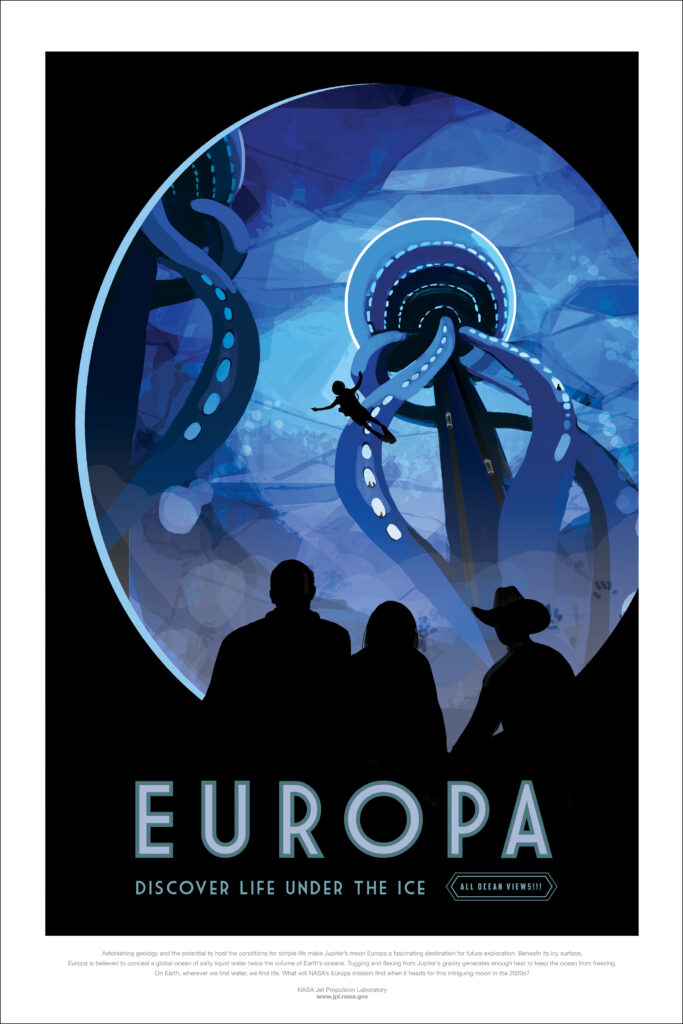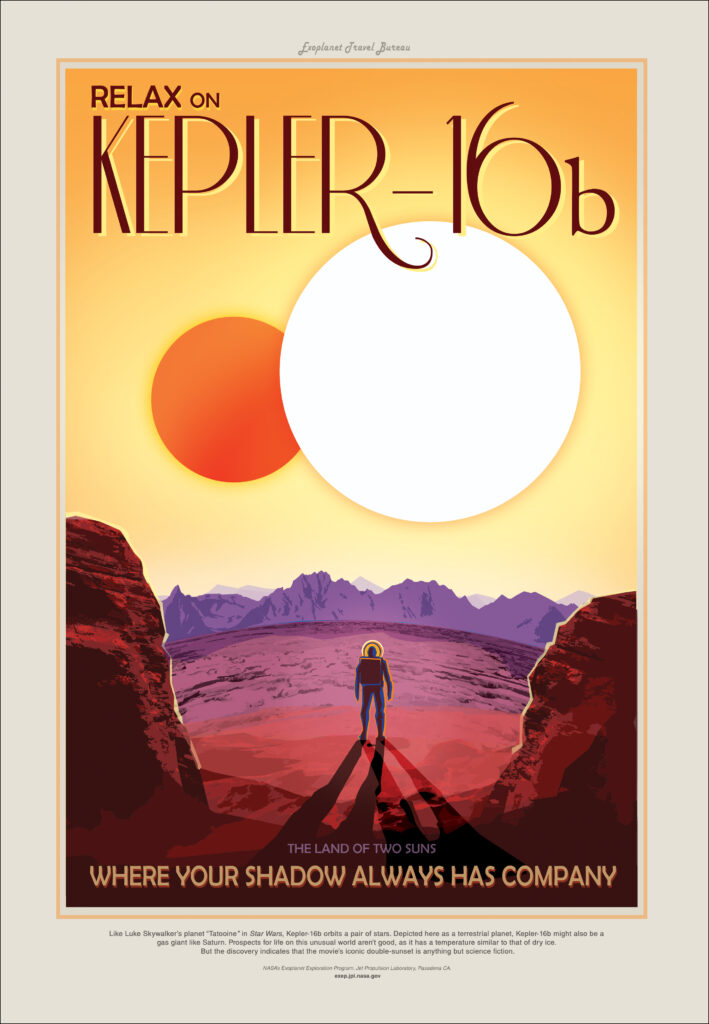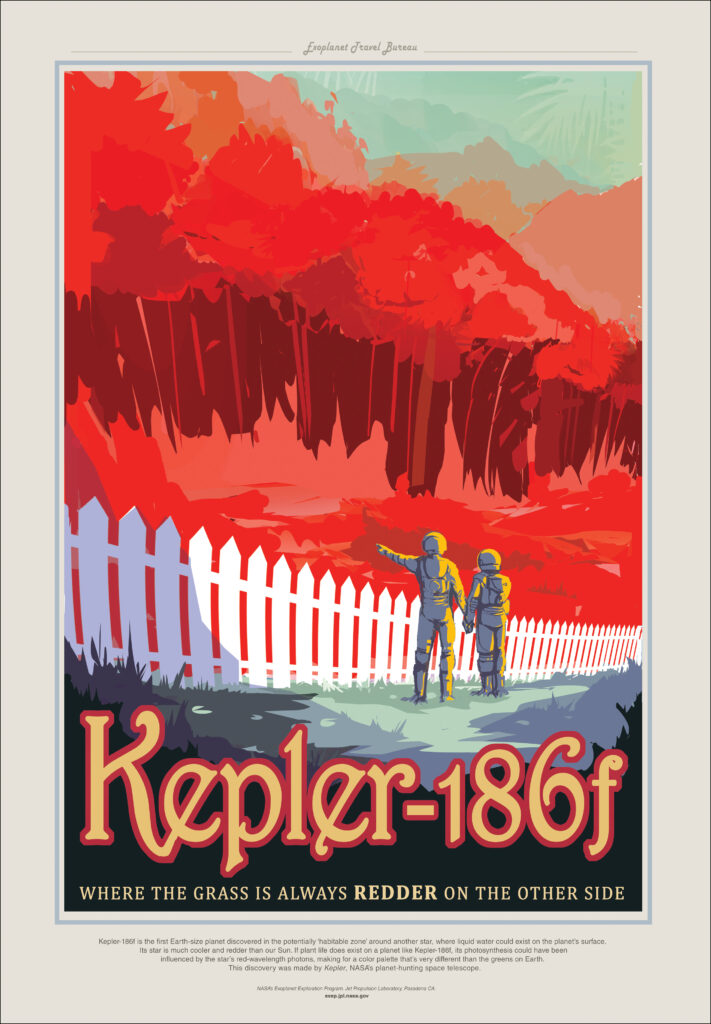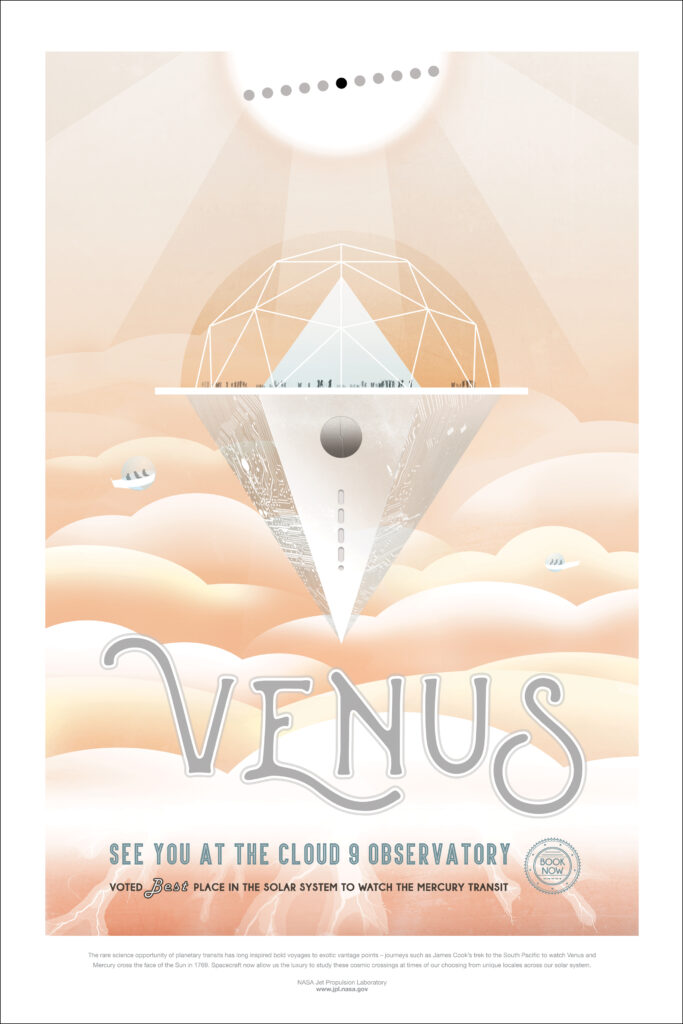Need on NASA disainitud (täna veel) ulmelised plakatid. Kui oled sci-fi sõber ja ei ole neid veel näinud, siis siin nad on. Iga pildi all on ka huvitav tekst, mille olen siia eraldi välja kirjutanud, kuna pildi pealt seda siin välja ei loe. Trükitud posteri peal on see ka hästi loetav.
Siit saad endale tellida posterid ka trükitud kujul hästi soodsalt.
Postrid on 90×60 cm mõõdus. Hinnad:
plakatipaberil – 10 eur tk
fotokapa – 25 eur tk
fotolõuend – 29 eur tk
Küsimisel saab ka muudes mõõtudes ja materjalidele.
Transport: praegu ise järgi tulla ei saa. Pildid saab tellida TASUTA kulleriga koju, paberplakatit saab ka pakiautomaati tasuta.
Tellimiseks kirjuta soovitud plakati number ja materjal (paber, kapa või lõuend) info@minuprint.com. Kirjuta juurde ka kättesaamise viis.

1. 55 Canri e.
A global ocean of lava under sparklink, sillicate skies reflecting the lava below: what better choice for an extreme vacation? Planet Jansen, or 55 Cancri e, orbits a star called Copernicus only 41 light years away. The molten surface is completely uninhabitable, but you’ll ride safely above, taking breathtaking views: the burning horizon, Janssen’s sister planet Galileo hanging in a dark sky, and curtains of glowing particles as you glide across the terminator to Janssen’s dark side. Book your travel now to the hottest vacation spot in the galaxy, 55 Cancri e.

2. Ceres
Ceres is the closest dwarf planet to the Sun. It is the largest object in the main asteroid belt between Mars and Jupiter, with an equatorial diameter of about 965 kilometers. After being studied with telescopes for more than two centuries, Ceres became the first dwarf planet to be explored by a spacecraft, when NASA’s Dawn probe arrived in orbit in March 2015. Dawn’s ongoing detailed observations are revealing intriguing insights into the nature of this mysterious world of ice and rock.

3. Earth
There’s no place like home. Warm, wet and with an atmosphere that’s just right, Earth is the only place we know of with life – and lots of it. JPL’s Earth science missions monitor our home planet and how it’s changing so it can continue to provide a safe haven as we reach deeper into the cosmos.

4. Enceladus
The discovery of Enceladus’ icy jets and their role in creating Saturn’s E-ring is one of the top findings of the Cassini mission to Saturn. Further Cassini mission discoveries revealed strong evidence of a global ocean and the first signs of potential hydrothermal activity beyond Earth – making this tiny Saturnian moon one of the leading locations in the search for possible life beyond Earth.

5. HD 40307g
The discovery of Enceladus’ icy jets and their role in creating Saturn’s E-ring is one of the top findings of the Cassini mission to Saturn. Further Cassini mission discoveries revealed strong evidence of a global ocean and the first signs of potential hydrothermal activity beyond Earth – making this tiny Saturnian moon one of the leading locations in the search for possible life beyond Earth.

6. Europa
Astonishing geology and the potential to host the conditions for simple life make Jupiter’s moon Europa a fascinating destination for future exploration. Beneath its icy surface, Europa is believed to conceal a global ocean of salty liquid water twice the volume of Earth’s oceans. Tugging and flexing from Jupiter’s gravity generates enough heat to keep the ocean from freezing. On Earth, wherever we find water, we find life. What will NASA’s Europa mission find when it heads for this intriguing moon in the 2020s?

7. The Grand Tour
Astonishing geology and the potential to host the conditions for simple life make Jupiter’s moon Europa a fascinating destination for future exploration. Beneath its icy surface, Europa is believed to conceal a global ocean of salty liquid water twice the volume of Earth’s oceans. Tugging and flexing from Jupiter’s gravity generates enough heat to keep the ocean from freezing. On Earth, wherever we find water, we find life. What will NASA’s Europa mission find when it heads for this intriguing moon in the 2020s?

8. Jupiter
The Jovian cloudscape boasts the most spectacular light show in the solar system, with northern and southern lights to dazzle even the most jaded space traveler. Jupiter’s auroras are hundreds of times more powerful than Earth’s, and they form a glowing ring around each pole that’s bigger than our home planet. Revolving outside this auroral oval are the glowing, electric “footprints” of Jupiter’s three largest moons. NASA’s Juno mission will observe Jupiter’s auroras from above the polar regions, studying them in a way never before possible.

9. Kepler – 16b
The Jovian cloudscape boasts the most spectacular light show in the solar system, with northern and southern lights to dazzle even the most jaded space traveler. Jupiter’s auroras are hundreds of times more powerful than Earth’s, and they form a glowing ring around each pole that’s bigger than our home planet. Revolving outside this auroral oval are the glowing, electric “footprints” of Jupiter’s three largest moons. NASA’s Juno mission will observe Jupiter’s auroras from above the polar regions, studying them in a way never before possible.

10. Kepler – 186f
Kepler-186f is the first Earth-size planet discovered in the potentially ‘habitable zone’ around another star, where liquid water could exist on the planet’s surface. Its star is much cooler and redder than our Sun. If plant life does exist on a planet like Kepler-186f, its photosynthesis could have been influenced by the star’s red-wavelength photons, making for a color palette that’s very different than the greens on Earth. This discovery was made by Kepler, NASAs planet-hunting space telescope.

11. Mars
NASA’s Mars Exploration Program seeks to understand whether Mars was, is, or can be a habitable world. Missions like Mars Pathfinder, Mars Exploration Rovers, Mars Science Laboratory and Mars Reconnaissance Orbiter, among many others, have provided important information in understanding of the habitability of Mars. This poster imagines a future day when we have achieved our vision of human exploration of Mars and takes a nostalgic look back at the great imagined milestones of Mars exploration that will someday be celebrated as “historic sites.”

12. First Exoplanet
While there is much debate over which exoplanet discovery is considered the “first,” one stands out from the rest. In 1995, scientists discovered 51 Pegasi b, forever changing the way we see the universe and our place in it. The exoplanet is about half the mass of Jupiter, with a seemingly impossible, star-hugging orbit of only 4.2 Earth days. Not only was it the first planet confirmed to orbit a sun-like star; it also ushered in a whole new class of planets called Hot Jupiters: hot, massive planets orbiting closer to their stars than Mercury. Today, powerful observatories like NASA’s Kepler space telescope, will continue the hunt of distant planets.

13. PSO J318.5 – 22
Discovered in October 2013 using direct imaging, PSO J318.5-22 belongs to a special class of planets called rogue, or free-floating, planets. Wandering alone in the galaxy, they do not orbit a parent star. Not much is known about how these planets come to exist, but scientists theorize that they may be either failed stars or planets ejected from very young systems after an encounter with another planet. These rogue planets glow faintly from the heat of their formation. Once they cool down, they will be dancing in the dark. Confirmed and candidate exoplanets and all available data are listed in the NASA Exoplanet Archive.

14. Titan
Frigid and alien, yet similar to our own planet billions of years ago, Saturn’s largest moon, Titan, has a thick atmosphere, organic-rich chemistry and a surface shaped by rivers and lakes of liquid ethane and methane. Cold winds sculpt vast regions of hydrocarbon-rich dunes. There may even be cryovolcanoes of cold liquid water. NASA’s Cassini orbiter was designed to peer through Titan’s perpetual haze and unravel the mysteries of this planet-like moon.

15. Trappist – 1e
Some 40 light-years from Earth, a planet called TRAPPIST-1e offers a heart-stopping view: brilliant objects in a red sky, looming like larger and smaller versions of our own moon. But these are no moons. They are other Earth-sized planets in a spectacular planetary system outside our own. These seven rocky worlds huddle around their small, dim, red star, like a family around a campfire. Any of them could harbor liquid water, but the planet shown here, fourth from the TRAPPIST-1 star, is in the habitable zone, the area around the star where liquid water is most likely to be detected. This system was revealed by the TRAnsiting Planets and Planeteslmals Small Telescope (TRAPPIST) and NASA’s Spitzer Space Telescope. The planets also are excellent targets for NASA’s James Webb Space Telescope. Take a planet-hopping excursion through the TRAPPIST-1 system.

16. Venus
The rare science opportunity of planetary transits has long inspired bold voyages to exotic vantage points – journeys such as James Cook’s trek to the South Pacific to watch Venus and Mercury cross the face of the Sun in 1769. Spacecraft now allow us the luxury to study these cosmic crossings at times of our choosing from unique locales across our solar system.
